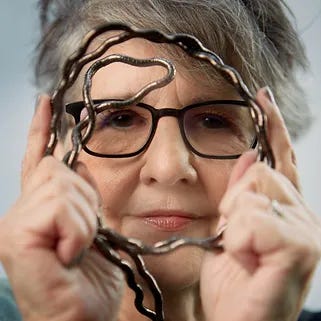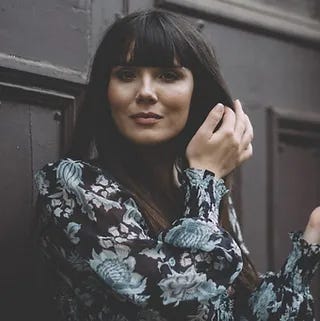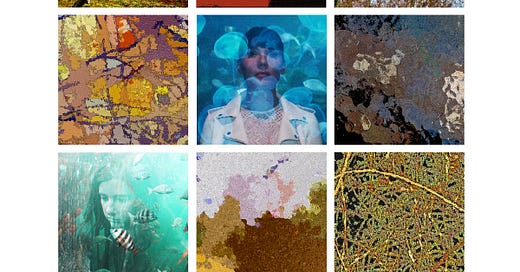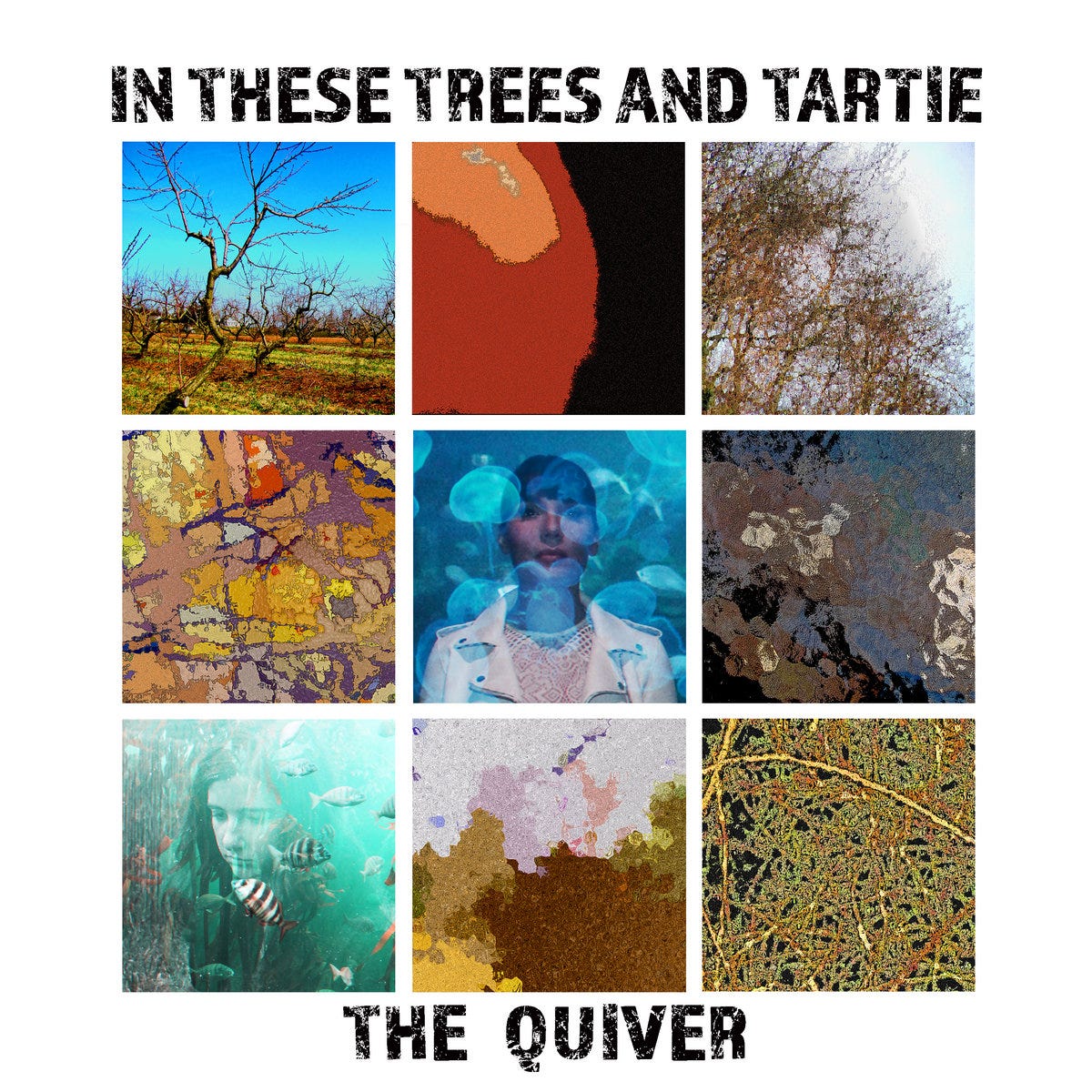Interview: Binnie Klein of In These Trees
A lifetime adventure under her belt, Klein has now added a new entry: songwriter.
Hey there! You’ve landed at On Repeat Records, a newsletter & community recently described as ‘the nicest place on the internet.’ If you’ve been looking for an engaged community of people who share your love of music, you’re in the right spot.
We don’t run ads here. On Repeat is made entirely possible through the support of our paid supporters. You can back independent ad-free music journalism for less than $1 a week.
Binnie Klein has never met an adventure she didn’t like. She’s a psychotherapist. Host a radio show. For a time she even took up boxing. So it only stood to reason that at some point she’d add “songwriter” to her lengthy CV.
Sometimes something extraordinary is born of something normal. In These Trees came to be when Australian singer Tartie emailed Klein, asking her to play her music on the air. They began corresponding, and before either knew it, they collaborated on a record. On The Quiver, Tartie brings Klein's lyrics to life. The result is a gorgeous record built by two people on opposite sides of the world.
From Connecticut on one end to Australia on the other, the two have come together to create 10 songs that use pop melodies and smooth sounds to take on topics like the climate, and memories of past lives. The two have never met in person, but you'd never know it listening to the record. This sounds like it was made by people that have known each other for years. You could make the argument that this is another pandemic project, but it’s hard to argue the gorgeous results.
Listening to The Quiver is quite an adventure.
I recently had a chance to talk with Binnie via email. In a wide-ranging chat, we talk about how this project came to be, some adventures along the way, and one of her more famous coworkers at the radio station.
Our conversation has been lightly edited for clarity and flow.
Congrats on the new record! Quiver got its start as a leap of faith on your part. Can you walk us through how you connected with Tartie and how that ultimately led to the record coming to pass?
Thanks, Kevin! And congrats to YOU on this impressive Substack. Like most DJ’s (I host at WPKN), I get tons of submissions from eager indie artists who present as being a great match for my show, “A Miniature World.” I try to listen to as many as I can, but “Heavy Metal” bands and “Garage punk” and “Christian Rock” go straight to delete; I understand the desire to promote, but I can tell when someone has never heard my show.
There was something charming, straightforward, and winning about the email I received from Australian singer/songwriter Tartie. When I checked out some of her tunes on You Tube, I was profoundly struck by the quality of her voice–authentic, passionate, eager. I immediately thought: she should be more well known.
I played her song “Winter’s Girl” on my show. The unexpected happened when I asked Tartie if she would take a look at some of my own lyrics. Although I am a long-time writer (poet, essay, memoir), I had just begun to write songs. She returned with a rough demo of “Orchard” with vocal and keyboard. “Orchard” is both a poignant processing of an early heartbreak that also functions as a song with a warning about climate change. “Won’t you leave this orchard/ won’t you leave this town/ and let me grow tangled/let me dry; let all the fruits fall down!”
Tartie’s artistry matching my lyrics with her melody thrilled me. I was operating on, as they say, a hope and prayer, and sent the demo to producer David Baron, who I knew from the Woodstock, NY area. He loved it, and we began to conceptualize an arrangement, with piano and cello. I sent Tartie several more songs, and she never disappointed. That we were working on different continents, and of very different ages and lives – all that receded as a magical alchemy took hold.
For the next few songs, “Sky, Ocean, “Dilemma,” and “Quiver” (they were pouring out!) I drove up from Connecticut to Baron’s studio in Boiceville, New York. We arranged some remarkably talented local musicians for several- day sessions. Baron put together Tartie’s vocals, sent electronically, with mixes we created.
One day, as I was leaving the studio, Baron said “you know, you two are quite prolific, and you have a fabulous backstory here – you should think about doing an album.”
Correct me if I’m wrong, but you’ve been a musician before but this is the first time as a songwriter, yes? How was hearing your words coming to life and sung by someone else?
From the shiny red rented “junior accordion” of grade school to the used baby grand piano my traveling salesman father scored free for our second floor apartment in Newark, NJ—which he claimed had been played by Leonard Bernstein and had cigarette burn marks to prove it— and then the classic “Kay” acoustic guitar with the neck-too-wide for my small hands, to the Yamaha Console piano (still with me!) to the borrowed Selmer alto saxophone with which I learned to play an elegant “G” from saxophone god Lee Konitz on the Upper West Side of Manhattan to the G&L electric guitar purchased to celebrate my Masters in Social work (for the punk band I wanted to form called “Les Tchotchkes”) and most recently a Yamaha electric keyboard and Ibanez acoustic with electric pick-up and slender neck – I’ve been music crazy for most of my life.
Lessons taken on piano with Mr. Levy, a short man whose longish nails clicked against the keys were probably the most influential. I thank my parents for making those lessons possible. Once you can read music, it’s part of a language that opens many doors. I’m still no genius on the bass clef, but since 14 years old or so, I could pick up a rock or pop songbook and plunk it out. Lee Konitz, during my jazz journey (in my early twenties), had me scat sing along with Charlie Parker records, and I was famous for singing Billie Holiday lines at accelerated speeds.
This CD does mark my first time as a songwriter; you’re absolutely correct. Despite a lifetime of writing, words didn’t form into songs the way the poems spilled out, with eerie conviction. I’d do a fair amount of improvising on the piano as if I were creating dramatic symphonies, but no “songs” per se.
When Tartie sent back the demo for the first song, “Orchard,” for which I had written the lyrics, listening was ecstasy. I felt thrilled. I felt like something creative had moved out of me, all the way to Australia where she lived, and lived in her for a time, and was sent back to me on magical wings. In short, it felt great.


This isn’t the first “pivot” you’ve done. When we first met, you spoke of having gotten involved with amateur boxing. How the heck did that happen? Did anything you took away from that come into play here?
In my mid-fifties, I broke my ankle and foot on my way to fill the backyard bird feeder. Some kind of divot in the uneven ground. Agony; it was my first broken bone after growing up in an aggressively sedentary family.
In rehab, I spotted boxing gloves and asked the trainer to show me how to hit punch mitts. I fell in love with it. My ankle healed enough so that I could kick pads, too. I worked hard; I didn’t want to become of those cautious old ladies, fearful of falling. One day, the AARP bulletin arrived, with a story of a former Intermediate Heavyweight champion IN MY TOWN teaching middle-aged women to box !
I was a poseur, of course, never meant to be in the ring, but when I learned about the little-known history of Jewish boxers, I began a self-guided research project. It meant a lot to me to know about these boxers, and led to various unexpected experiences like sparring with John, learning to be comfortable with my own aggression, attending some pro fights, and writing about them, attending Gleason’s Fantasy Boxing Camp in the Catskills one summer, and publishing a memoir, Blows to the Head: How Boxing Changed My Mind (SUNY PRESS, 2010).
I’m glad you asked if anything endured from that adventure that has relevance in the songwriting. Yes! Both wild turns in the road have involved saying “yes” to impulse, urge, instinct, curiosity, ambition, and doing things I never imagined doing. Just as people would say “YOU are boxing?” Now they say “You put out a music CD?”
You and Tartie have lined up an incredible group of musicians here. Did you know them from your work in radio?
Not exactly. For example, I’m thrilled that we were able to get virtuoso guitarist Jeff Pevar to work on 3 songs. I had seen him play at a gig in Connecticut years before, and fell in love with his guitar style (that cover of Little Wing!). I mentioned him to producer Baron, who said “let’s reach out.” He said yes, and working with him, even remotely, was a fantastic experience. He sent me notes, ideas, samples. I’ve got lots of stems to play with!
Another idea came to me when we were working on Ablaze and Hailstorm - I wanted the wailing sound of background female vocals. I guess you could say radio came into it here, but not out of personally knowing a musician, but knowing their music, and having played it on my show. I’d played Ulali, a Native American trio who appeared with Robbie Roberston. Baron heard of them and happened to know that one of the members, Jennifer Kreisberg, lived in Connecticut! I sent her a demo of Ablaze and she fell in love with it, and Tartie’s voice. She’s very picky about anything too “pop” so Hailstorm wasn’t in her usual wheelhouse, but she did an amazing job with it. I met her for the session at Silk City Studios in Manchester, where she does her current recording (her earthy, wailing style is unique and her work is often used in soundtracks to documentaries).
I thought of Jerry Marotta for unusual percussion sounds and knew he has a Woodstock studio. He played on Hailstorm, with input from me about types of percussion instruments I wanted. Baron was fantastic in suggesting string musicians for cello and viola.
The rest of the musicians were suggested by Baron. John Andrews, a guitarist touring in Europe now with Nena, Ben Zwerin, bassist, Aaron Johnston and Jeff Lipstein, drummers. And of course, kudos to Baron himself for his phenomenal piano and synthesizer work.
Do you ever run into Chris Frantz at the station? What’s he like in person? Any stories you can share?
Ha ha - love the cheekiness of this question. Wish I had some witty anecdotes for you, but we’ve not as yet run into each other, but I do hear the celebrity-adjacent thrill in WPKN DJ’s voices when he’s mentioned!
What do you hope listeners take away from The Quiver?
Freud talked about dreams having manifest and latent meanings (oh boy, here we go…) The manifest is the story the dream tells, an imaginative creation pulling unconscious elements into a narrative.
The latent meaning is the interpretation, a disguised subtext. You explore your associations to the elements in the story and try to go deeper. In the debut song, “Orchard,” there is a 17 year old careless young boy stomping through the woods, causing havoc by breaking the young girl’s heart, or is the song about about forces bigger than him? Destroying the beautiful forests?
The manifest is a bit of a trickster. Some of the manifest stories of the songs involve adolescent heartbreak, recovery over a lifetime from various losses, heartbreak and other challenges, like the Velcro stickiness of obsessive love (with humor), new beginnings and starting again, going forward even when you have no idea what’s to come. There are also darker stories of mental struggles and environmental disasters.
Tartie’s beautiful climate anthem, “Ablaze” is about the Australian wildfires, and a plea to take care of our earth. The latent messages? Everyone is haunted by something, go deep into the memories, extract meaningful gems, there is solace in nature, and life is light and shadow. And more simply, Tartie and I wanted to bring something beautiful into the world.
What’s next for you? What’s the rest of 2024 look like?
I’m so involved with giving “The Quiver,” my “late-in-life baby’ a proper launch that it’s not clear what is next. As a new indie creator, I’m struggling through a crash course in the current music industry. I work constantly on trying to make potential listeners aware of this unique album, and to that end I’m going to be working with “A Man, A Plan, a Canal” on a radio promotion campaign this summer and fall. DJ Twyla Twang of KZUM, who is a big In These Trees supporter, hooked me up with them. I was impressed with their roster of artists – quirky, just like I like ‘em!
We have a few more videos of songs from the album that we’ll put up on YouTube, made by the amazingly talented Scott Shapleigh) You may hear some unusual remixes.
Before guitarist John Andrews went off to Germany, we started to play around with a folk ballad I’ve written about feminist author Simone deBeauvoir and her passion for hiking. I’d like to get back to that. There are a few local musicians I started some collaborations with, and I’d like to get back to that. There are lyrics waiting!
Meanwhile, the DJ in me produces two shows a month for WPKN, and I’ve launched a new series of interviews with musicians. I have adored working with Tartie; I’d be happy to do more. And I’m open to collaborations with other singers.
Listen:
In These Trees And Tartie | The Quiver, 2024
Click the record to listen on your platform of choice.
5 Questions:
Describe your music in one sentence.
You devil, you! By turns mystical, emotional, and uplifting, In These Trees and Tartie creates elegant soundscapes of piano and strings and unexpected instruments that nestle intriguing melodies, achingly expressive vocals, and relatable, poetic lyrics inside stand-out production.
What music played in your house growing up?
Mostly soundtracks to Broadway shows - West Side Story, South Pacific, Oklahoma, The King and I. My father was a big fan and one of the few more child-centered things he would do for us was take us to Radio City Music Hall in NYC to see premieres of the movie adaptations. The Rockettes - Very agile women in scant costumes all in a line, kicking their legs (high). Well, maybe not so child-centered, but it was better than the racetrack.
We also had—and these were all vinyl, played on some kind of furniture style stereo cabinet—Rhapsody in Blue by Gershwin, Bolero, Comedy albums by Tom Lehrer, and Nichols and May (their improv was like a kind of music).
In my teenage bedroom, with another turntable and a collection of MY albums you might find Dylan, Tom Rush, The Incredible String Band, the Beach Boys, Butterfield Blues Band, Mississippi John Hurt, Joan Baez, Beatles, Rolling Stones, Pink Floyd, Cream, Jimi Hendrix, Incredible String Band, Pentangle, Donovan, Jefferson Airplane, among others!
What are you listening to these days?
I like London Grammar, Caroline Polachek, Hozier, The National
What are your 5 desert discs?
I gotta have The Sensual World by Kate Bush, For the Roses by Joni Mitchell, After the Gold Rush by Neil Young, The single of Horizon by Aldous Harding, and the Laurie Anderson Anthology (is that cheating–more than one disc?)
If you could collaborate with any artist/band, who would it be?
Ooh, I like this one! You might have to let me mention a few. I have a song I want Brandi Carlisle to sing. I have a new song, “Blue Ford Falcon” that I’d like to work with singer Arum Rae on. The National!!!! Oh, Matt Berninger, let me write a poetic, sad dad ballad for you. Also, I’m ready to work with loops and synths and explore the world of chill. My years of curating radio shows have filled my new songwriter head with a multitude of genres. Eclectic but not scattered!
What did you think of the record? Do you have a favorite track on The Quiver? Any other thoughts or comments?
Connect with In These Trees and Tartie: | Website | Bandcamp | Instagram | Spotify |
Thank you to Binnie Klein for her time, and thank you for being here.
Kevin—







What can I say, Kevin Alexander, music midwife and maven? Thank you for the opportunity to talk about my new album!!!! Tartie and I are very grateful on behalf of our album "The Quiver" by In These Trees and Tartie.
I loved your questions and her responses. Mind-blowing process all around. I cannot even imagine how exciting it must have been for her to listen to her lyrics for the first time.